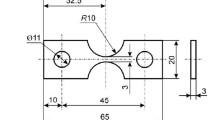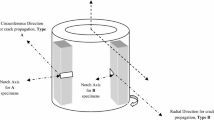Abstract
Ten different alloys based on the 7075 composition were used to study the effect of purity level, dispersoid type, and heat treatment on fracture toughness. Five purity levels ranging from 0.03 to 0.30 wt pct Fe + Si and two dispersoid types were investigated. Each alloy was given two heat treatments: the standard T651 heat treatment or a special thermomechanical treatment (TMT). Fracture toughness was measured using notched round tensile specimens taken from both the longitudinal and long-transverse directions. The notched round tensile test was modified to give the “plastic energy per unit area”. This fracture toughness parameter gave the same ranking for corresponding alloy/heat treatment combinations as the total energy per unit area measured on precracked Charpy specimens. The fracture toughness ranking for the ten alloys was the same in the longitudinal and long-transverse directions. This suggests the elongated distribution of constituent particles in the rolling direction does not change the failure mechanism. Fractographic evidence showed a bimodal distribution of ductile dimple size in all ten alloys. The number of large ductile dimples decreased with increasing purity level while the number of small ductile dimples increased. This is interpreted to mean that the smaller dispersoid and hardening particles become increasingly important in controlling the fracture toughness as the large intermetallic particles are eliminated by increasing the purity of these aluminum alloys. Since thermomechanical processing controls the amount and type of these smaller particles, it is a useful means for increasing fracture toughness in high purity aluminum alloys.
Similar content being viewed by others
References
Influence of Iron and Silicon Content on the Tensile Properties of 7X75 and Zr-Modified 7X75 Aluminum Plate, Technical Report Number AFML-TR-75- 140, July 1975, Air Force Materials Laboratory, WPAFB, OH. (Available through NTIS, Department of Commerce, Springfield, Va. 22151.)
Effect of Iron and Silicon Content on Stress Corrosion Cracking in a Thermo- mechanically Processed Aluminum Alloy, Technical Report Number AFML- TR-75-43, July 1975, Air Force Materials Laboratory, WAPFB, OH. (Available through NTIS, Department of Commerce, Springfield, Va. 22151.)
Effect of Iron and Silicon Content on the Fracture Toughness of 7X75 and Zr-Modified 7X75 Aluminum Plate, Technical Report Number AFML-TM-LL-75-10, July 1975, Air Force Materials Laboratory, WPAFB, OH. (Available through NTIS, Department of Commerce, Springfield, Va. 22151.)
High Strength Aluminum Alloy Development, Technical Report Number AFML-TR-70-171, August 1970, Air Force Materials Laboratory, WPAFB, OH. (Available through NTIS, Department of Commerce, Springfield, Va. 22151.)
M. V. Hyatt and W. E. Quist: unpublished Boeing data 1967.
A. S. Tetelman and A. J. McEvily, Jr.:Fracture of Structural Materials, New York, John Wiley and Sons, Inc., 1967.
Program to Improve the Fracture Toughness and Fatigue Resistance of Alumi- num Sheet and Plate for Airframe Applications, Technical Report Number AFML-TR-73-224, September 1973, Air Force Materials Laboratory, WPAFB, OH 45433. (Available through NTIS, Department of Commerce, Springfield, Va. 22151.)
J. Waldman, H. Sulinski, and H. Markus:Met. Trans., 1974, vol. 5, pp. 573–84.
P.J. Blau:Metallogr., 1975,,vol. 7, pp. 187–201.
1975 Annual Book of ASTM Standards, Part 10:Metals-Mechanical, Fracture,and Corrosion Testing;Fatigue;Erosion;Effect of Temperature. Proposed Method for Sharp-Notch Tension Testing of Thick High-Strength Aluminum and Magnesium Alloy Products with Cylindrical Specimens, pp. 799-810.
J. S. Santner and A. Gunderson:Development of a Low Cost Reliable Test to Verify Fracture Toughness of Light Metal Alloys, Mini-Symposium of New Avenues for Progress in Aerospace Research Technology & Systems, WPAFB, OH, 25 March 1976.
Rapid Inexpensive Tests for Determining Fracture Toughness, Report of the Committee on Rapid Inexpensive Tests for Determining Fracture Toughness, National Materials Advisory Board, Publication NMAB-328, National Academy of Science, Washington, D.C., 1976, (Available from Printing and Publishing Office, National Academy of Sciences, 2101 Constitution Avenue, N.W., Washington, D.C. 20418.)
A. W. Thompson and P. F. Weihrauch:Scripta Met., 1976, vol. 10, pp. 205–10.
T. M. F. Ronald, J. A. Hall, and C. M. Pierce:Met. Trans., 1972, vol. 3, pp. 813–18.
Research on Synthesis of High-Strength Aluminum Alloys, Technical Report Number AFML-TR-72-199, Part II, July 1973, Air Force Materials Laboratory, WPAFB, OH, (Available through NTIS, Department of Commerce, Springfield, Va. 22151.)
G. T. Hahn and A. R. Rosenfield:Met. Trans. A, 1975, vol. 6A, pp. 653–70.
G. T. Hahn and A. R. Rosenfield:Relations Between Microstructure and the Fracture Toughness of Metals, Third International Conference on Fracture, Paper PL-III-211, Munich, 1973.
D. Broek:A Study on Ductile Fracture, National Aerospace Laboratory, NRL, The Netherlands, NLR-TR-71021U, 1971.
R. H. Van Stone and J. A. Psioda:Met. Trans. A, 1975, vol. 6A, pp. 668–70.
J. S. Santner and M. E. Fine:Met. Trans. A, 1976, vol. 7A, pp. 601–04.
Damage Tolerant Design Handbook, Part I, January 1975, distributed by the National Technical Information Services, U.S. Department of Commerce, Springfield, Va. 22151.
E. DiRusso, M. Conserva, F. Gatto, and H. Markus:Met. Trans., 1973, vol. 4, pp. 1133–44.
W. H. Reimann and A. W. Brisbane:Eng. Fract. Mech., 1973, vol. 5, pp. 67–78.
Improvement of Helicopter Forgings by Controlled Solidification and Thermal- Mechanical Treatments, U.S. Army Aviation Systems Command, AVSCOM Report No. 76-41, October 1976, St. Louis, Mo. 63166. (Available through NTIS, U.S. Department of Commerce, Springfield, VA 22151.)
Metallurgical Factors Controlling Structure in High Strength Aluminum P/M Products, Technical Report Number AFML-TR-76-60, May 1976, Air Force Materials Laboratory, WPAFB, OH 45433. (Available through NTIS, U.S. De- partment of Commerce, Springfield, Va. 22151.)
J. M. Van Orden and D. E. Pettit:MetalProgr., 1977, vol. 112, no. 8, pp. 28- 31.
Author information
Authors and Affiliations
Additional information
An erratum to this article is available at http://dx.doi.org/10.1007/BF02652264.
Rights and permissions
About this article
Cite this article
Santner, J.S. A study of fracture in high purity 7075 aluminum alloys. Metall Trans A 9, 769–779 (1978). https://doi.org/10.1007/BF02649786
Received:
Issue Date:
DOI: https://doi.org/10.1007/BF02649786




